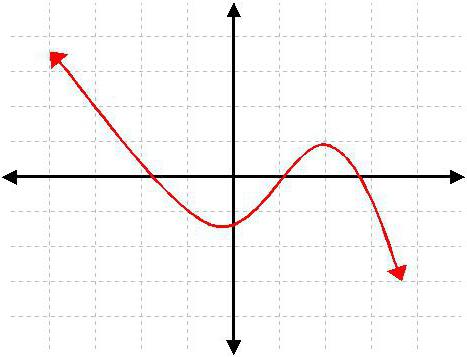Parity of function
The parity and oddness of a function are one of theits basic properties, and the study of the function on parity occupies an impressive part of the school course in mathematics. It determines in many ways the behavior of the function and greatly facilitates the construction of the corresponding schedule.
Let us determine the parity of the function. Generally speaking, the function being examined is considered even if the corresponding values of y (functions) are equal for opposite values of the independent variable (x) in its domain of definition.
We give a more rigorous definition. We consider a function f (x) that is defined in D. It will be even if for any point x in the domain of definition:
- -x (the opposite point) also lies in this domain of definition,
- f (-x) = f (x).
From the above definition,namely, the symmetry with respect to the point O, which is the origin, since if some point b is contained in the domain of definition of an even function, then the corresponding point - b also lies in this region. From the above, thus, the conclusion follows: the even function has a symmetrical form with respect to the ordinate axis (Oy).
How to determine in practice the parity of a function?
Let the functional dependence be given withUsing the formula h (x) = 11 ^ x + 11 ^ (- x). Following the algorithm that follows directly from the definition, we first of all examine its domain of definition. Obviously, it is defined for all values of the argument, that is, the first condition is satisfied.
The next step is to replace the argument (x) with its opposite value (-x).
We get:
h (-x) = 11 ^ (-x) + 11 ^ x.
Since the addition satisfies the commutative (relocatable) law, it is obvious that h (-x) = h (x) and the given functional dependence is even.
Let us verify the parity of the function h (x) = 11 ^ x-11 ^ (-x). Following the same algorithm, we obtain that h (-x) = 11 ^ (-x) -11 ^ x. Carrying a minus, in the end, we have
h (-x) = - (11 ^ x-11 ^ (-x)) = -h (x). Hence h (x) is odd.
By the way, it should be recalled that there are functions that can not be classified according to these characteristics, they are called neither even nor odd.
Even functions have a number of interesting properties:
- as a result of the addition of such functions, an even number is obtained;
- as a result of subtraction of such functions, an even result is obtained;
- the inverse of even function is also even;
- as a result of the multiplication of two such functions, an even number is obtained;
- as a result of multiplying odd and even functions get odd;
- as a result of dividing the odd and even functions get odd;
- the derivative of such a function is odd;
- if we raise the odd function to a square, we get an even function.
The parity of a function can be used to solve equations.
To solve an equation of the type g (x) = 0, where the leftpart of the equation is an even function, it will be sufficient to find its solutions for non-negative values of the variable. The roots of the equation must be combined with the opposite numbers. One of them is subject to verification.
The same property of the function is successfully used to solve non-standard tasks with a parameter.
For example, is there any value of the parameter a for which the equation 2x ^ 6-x ^ 4-ax ^ 2 = 1 will have three roots?
If we take into account that the variable enters the equation ineven degrees, it is clear that the change of x by - x the given equation does not change. Hence it follows that if some number is its root, then it is the opposite number. The conclusion is obvious: the roots of the equation, other than zero, enter into the set of its solutions "pairs".
It is clear that the number 0 itself is not the root of the equation, that is, the number of roots of such an equation can only be even and, naturally, for any value of the parameter it can not have three roots.
But the number of roots of the equation 2 ^ x +2 ^ (- x) = ax ^ 4 + 2x ^ 2 + 2 can be odd, and for any value of the parameter. Indeed, it is easy to verify that the set of roots of the given equation contains solutions "in pairs". Let us check whether 0 is a root. When we substitute it into the equation, we get 2 = 2. Thus, in addition to "paired" 0 also is a root, which proves their odd number.
</ p>>






